Case Study: Metoclopramide Pharmacokinetics & Clinical Decision Making
VerifiedAdded on 2022/08/11
|10
|2649
|24
Case Study
AI Summary
This case study examines metoclopramide, a dopamine antagonist used to treat nausea, focusing on its pharmacokinetic and pharmacodynamic properties within a clinical context. The study delves into the drug's absorption, distribution, metabolism, and excretion, including how these processes are affected by renal impairment. It explores the clinical decision-making process, including assessment before administration (e.g., allergic reactions, drug interactions), appropriate routes of administration (intravenous vs. oral), and safe implementation (right dose, right route). Non-pharmacological interventions like relaxation therapy are suggested to enhance effectiveness. The evaluation of administration includes assessing for medication errors and allergic reactions. The study emphasizes the importance of monitoring kidney function, understanding side effects, and making informed decisions to optimize patient outcomes, specifically in a patient with mild renal impairment and bowel obstruction.

Running head: CASE STUDY
CASE STUDY
Name of the student:
Name of the university:
Author note:
CASE STUDY
Name of the student:
Name of the university:
Author note:
Paraphrase This Document
Need a fresh take? Get an instant paraphrase of this document with our AI Paraphraser
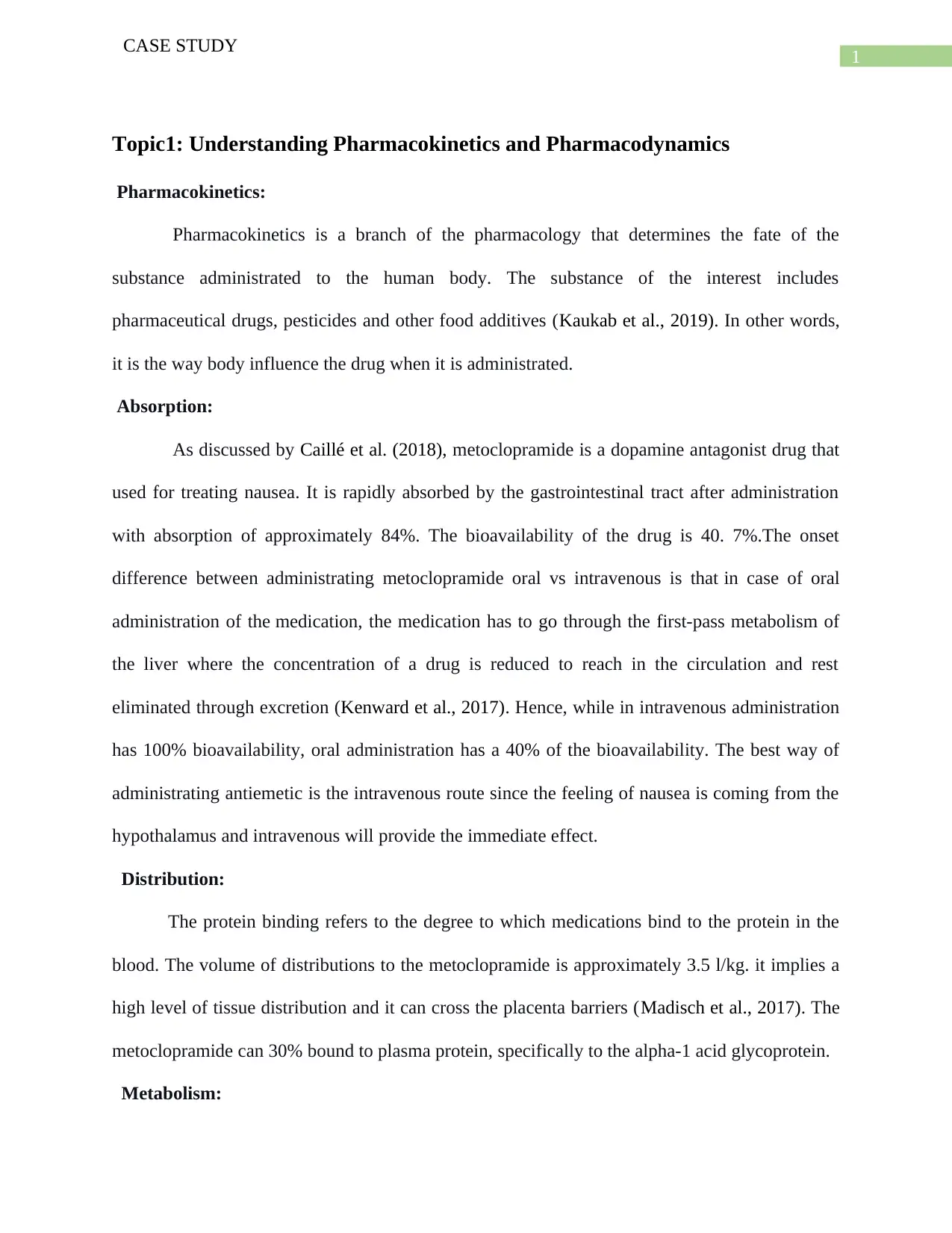
1
CASE STUDY
Topic1: Understanding Pharmacokinetics and Pharmacodynamics
Pharmacokinetics:
Pharmacokinetics is a branch of the pharmacology that determines the fate of the
substance administrated to the human body. The substance of the interest includes
pharmaceutical drugs, pesticides and other food additives (Kaukab et al., 2019). In other words,
it is the way body influence the drug when it is administrated.
Absorption:
As discussed by Caillé et al. (2018), metoclopramide is a dopamine antagonist drug that
used for treating nausea. It is rapidly absorbed by the gastrointestinal tract after administration
with absorption of approximately 84%. The bioavailability of the drug is 40. 7%.The onset
difference between administrating metoclopramide oral vs intravenous is that in case of oral
administration of the medication, the medication has to go through the first-pass metabolism of
the liver where the concentration of a drug is reduced to reach in the circulation and rest
eliminated through excretion (Kenward et al., 2017). Hence, while in intravenous administration
has 100% bioavailability, oral administration has a 40% of the bioavailability. The best way of
administrating antiemetic is the intravenous route since the feeling of nausea is coming from the
hypothalamus and intravenous will provide the immediate effect.
Distribution:
The protein binding refers to the degree to which medications bind to the protein in the
blood. The volume of distributions to the metoclopramide is approximately 3.5 l/kg. it implies a
high level of tissue distribution and it can cross the placenta barriers (Madisch et al., 2017). The
metoclopramide can 30% bound to plasma protein, specifically to the alpha-1 acid glycoprotein.
Metabolism:
CASE STUDY
Topic1: Understanding Pharmacokinetics and Pharmacodynamics
Pharmacokinetics:
Pharmacokinetics is a branch of the pharmacology that determines the fate of the
substance administrated to the human body. The substance of the interest includes
pharmaceutical drugs, pesticides and other food additives (Kaukab et al., 2019). In other words,
it is the way body influence the drug when it is administrated.
Absorption:
As discussed by Caillé et al. (2018), metoclopramide is a dopamine antagonist drug that
used for treating nausea. It is rapidly absorbed by the gastrointestinal tract after administration
with absorption of approximately 84%. The bioavailability of the drug is 40. 7%.The onset
difference between administrating metoclopramide oral vs intravenous is that in case of oral
administration of the medication, the medication has to go through the first-pass metabolism of
the liver where the concentration of a drug is reduced to reach in the circulation and rest
eliminated through excretion (Kenward et al., 2017). Hence, while in intravenous administration
has 100% bioavailability, oral administration has a 40% of the bioavailability. The best way of
administrating antiemetic is the intravenous route since the feeling of nausea is coming from the
hypothalamus and intravenous will provide the immediate effect.
Distribution:
The protein binding refers to the degree to which medications bind to the protein in the
blood. The volume of distributions to the metoclopramide is approximately 3.5 l/kg. it implies a
high level of tissue distribution and it can cross the placenta barriers (Madisch et al., 2017). The
metoclopramide can 30% bound to plasma protein, specifically to the alpha-1 acid glycoprotein.
Metabolism:
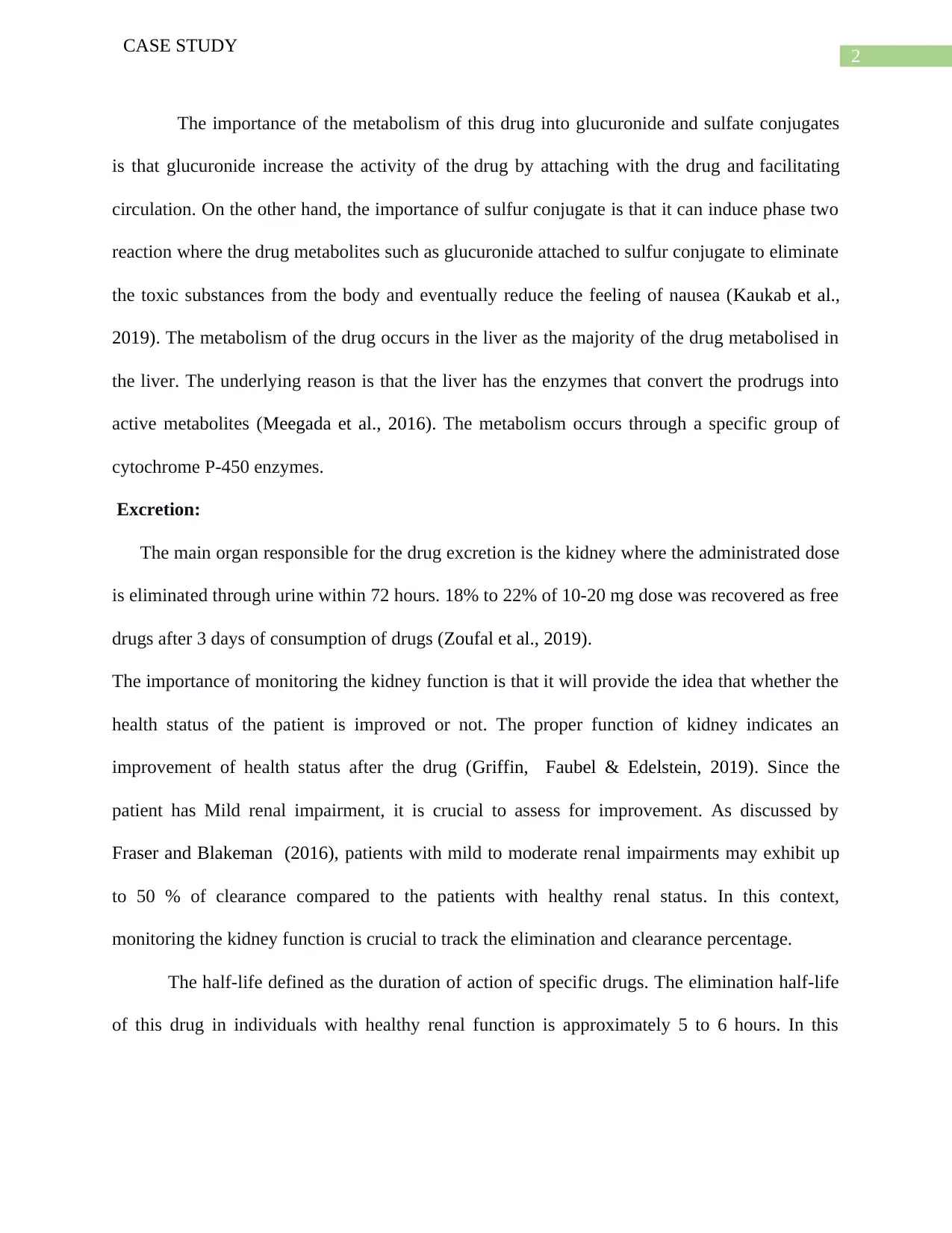
2
CASE STUDY
The importance of the metabolism of this drug into glucuronide and sulfate conjugates
is that glucuronide increase the activity of the drug by attaching with the drug and facilitating
circulation. On the other hand, the importance of sulfur conjugate is that it can induce phase two
reaction where the drug metabolites such as glucuronide attached to sulfur conjugate to eliminate
the toxic substances from the body and eventually reduce the feeling of nausea (Kaukab et al.,
2019). The metabolism of the drug occurs in the liver as the majority of the drug metabolised in
the liver. The underlying reason is that the liver has the enzymes that convert the prodrugs into
active metabolites (Meegada et al., 2016). The metabolism occurs through a specific group of
cytochrome P-450 enzymes.
Excretion:
The main organ responsible for the drug excretion is the kidney where the administrated dose
is eliminated through urine within 72 hours. 18% to 22% of 10-20 mg dose was recovered as free
drugs after 3 days of consumption of drugs (Zoufal et al., 2019).
The importance of monitoring the kidney function is that it will provide the idea that whether the
health status of the patient is improved or not. The proper function of kidney indicates an
improvement of health status after the drug (Griffin, Faubel & Edelstein, 2019). Since the
patient has Mild renal impairment, it is crucial to assess for improvement. As discussed by
Fraser and Blakeman (2016), patients with mild to moderate renal impairments may exhibit up
to 50 % of clearance compared to the patients with healthy renal status. In this context,
monitoring the kidney function is crucial to track the elimination and clearance percentage.
The half-life defined as the duration of action of specific drugs. The elimination half-life
of this drug in individuals with healthy renal function is approximately 5 to 6 hours. In this
CASE STUDY
The importance of the metabolism of this drug into glucuronide and sulfate conjugates
is that glucuronide increase the activity of the drug by attaching with the drug and facilitating
circulation. On the other hand, the importance of sulfur conjugate is that it can induce phase two
reaction where the drug metabolites such as glucuronide attached to sulfur conjugate to eliminate
the toxic substances from the body and eventually reduce the feeling of nausea (Kaukab et al.,
2019). The metabolism of the drug occurs in the liver as the majority of the drug metabolised in
the liver. The underlying reason is that the liver has the enzymes that convert the prodrugs into
active metabolites (Meegada et al., 2016). The metabolism occurs through a specific group of
cytochrome P-450 enzymes.
Excretion:
The main organ responsible for the drug excretion is the kidney where the administrated dose
is eliminated through urine within 72 hours. 18% to 22% of 10-20 mg dose was recovered as free
drugs after 3 days of consumption of drugs (Zoufal et al., 2019).
The importance of monitoring the kidney function is that it will provide the idea that whether the
health status of the patient is improved or not. The proper function of kidney indicates an
improvement of health status after the drug (Griffin, Faubel & Edelstein, 2019). Since the
patient has Mild renal impairment, it is crucial to assess for improvement. As discussed by
Fraser and Blakeman (2016), patients with mild to moderate renal impairments may exhibit up
to 50 % of clearance compared to the patients with healthy renal status. In this context,
monitoring the kidney function is crucial to track the elimination and clearance percentage.
The half-life defined as the duration of action of specific drugs. The elimination half-life
of this drug in individuals with healthy renal function is approximately 5 to 6 hours. In this
⊘ This is a preview!⊘
Do you want full access?
Subscribe today to unlock all pages.

Trusted by 1+ million students worldwide

3
CASE STUDY
context, the renal clearance of metoclopramide is 0.16 L/h/kg with a total 0.7l/h/kg (Kaukab et
al., 2019).
Pharmacodynamics:
The pharmacodynamics deals with the branch of pharmacology that focused on the
effects of drugs and the mechanism of their action (Madisch et al., 2017).Metoclopramide
increases the emptying the gastric by decreasing lower oesophagal sphincter pressure. Moreover,
it influences the postrema of the brain by preventing as well as relieving the symptoms of nausea
and vomiting. The exhibits antiemetic effects by inhibiting Dopamine D2 and serotonin 5-HT3
receptors in the chemoreceptor trigger zone of the brain (Madisch et al., 2017). Hence, the drugs
lead to the prokinetic effects through inhibition of presynaptic and postsynaptic D2 receptors. In
this context, this drug increases the gastrointestinal motility without maximizing the pancreatic
secretion. Since the drugs exhibit antidopaminergic effective, it can induce a range of symptoms
such as dystonia, tardive dyskinesia.
Side effects:
As metoclopramide produces a transient increase in plasma aldosterone, patients with
hypertension are at high risk of developing fluid retention and volume occurs as observed in this
case study. The fluid retention can impact patients as the patient has a bowel obstruction. The
drug also stimulates the release of catecholamine which may lead to hypertensive crisis (Elev et
al., 2018). On the other hand, the patients with mild renal impairment as observed in this case
scenario can experience toxicity which may result in an increase of creatinine in blood followed
by swelling, oedema and confusion.
CASE STUDY
context, the renal clearance of metoclopramide is 0.16 L/h/kg with a total 0.7l/h/kg (Kaukab et
al., 2019).
Pharmacodynamics:
The pharmacodynamics deals with the branch of pharmacology that focused on the
effects of drugs and the mechanism of their action (Madisch et al., 2017).Metoclopramide
increases the emptying the gastric by decreasing lower oesophagal sphincter pressure. Moreover,
it influences the postrema of the brain by preventing as well as relieving the symptoms of nausea
and vomiting. The exhibits antiemetic effects by inhibiting Dopamine D2 and serotonin 5-HT3
receptors in the chemoreceptor trigger zone of the brain (Madisch et al., 2017). Hence, the drugs
lead to the prokinetic effects through inhibition of presynaptic and postsynaptic D2 receptors. In
this context, this drug increases the gastrointestinal motility without maximizing the pancreatic
secretion. Since the drugs exhibit antidopaminergic effective, it can induce a range of symptoms
such as dystonia, tardive dyskinesia.
Side effects:
As metoclopramide produces a transient increase in plasma aldosterone, patients with
hypertension are at high risk of developing fluid retention and volume occurs as observed in this
case study. The fluid retention can impact patients as the patient has a bowel obstruction. The
drug also stimulates the release of catecholamine which may lead to hypertensive crisis (Elev et
al., 2018). On the other hand, the patients with mild renal impairment as observed in this case
scenario can experience toxicity which may result in an increase of creatinine in blood followed
by swelling, oedema and confusion.
Paraphrase This Document
Need a fresh take? Get an instant paraphrase of this document with our AI Paraphraser

4
CASE STUDY
Topic 2: The Clinical Decision-Making Process (750words)
Assessment:
Information prior to the administration of metoclopramide:
The first information required prior to administering the drug is the allergic reaction to
the drugs. As discussed by Polasek et al. (2019), in certain patients, a range of medications can
induce type 1 hypersensitivity reaction and the patient may exhibit nausea, rashes and other
allergic airways. In this current context of the case study, in order to involve in safe
administration, it is crucial to assess the allergic reaction since the anaphylactic reaction can be
triggered due to the administration in severe cases. Moreover, the second information before
administrating medication is an adverse drug interaction. In order to administer the drug safely
and gain the effect, the adverse drug interaction is crucial as the adverse drug interaction may
induce toxicity through the antagonistic effect or may neutralize the effect of metoclopramide
(Le, 2019). Consequently, the drug may not act on Mrs Nobal to reduce nausea.
Appropriate route of the medication:
The best way of administrating metoclopramide is the intravenous route since the feeling
of nausea is coming from the hypothalamus and intravenous will provide the immediate effect as
the bioavailability of the intravenous medication is 100% whereas the bioavailability of the
medication through oral route is 30 to 40% (Le, 2019). Moreover, as Mrs Nobel has renal
impairment and requires up to 5 to 6 hours for action and clearance, the intravenous drug will
work immediately by influencing the postrema of the brain by preventing as well as relieving the
symptoms of nausea and vomiting.
CASE STUDY
Topic 2: The Clinical Decision-Making Process (750words)
Assessment:
Information prior to the administration of metoclopramide:
The first information required prior to administering the drug is the allergic reaction to
the drugs. As discussed by Polasek et al. (2019), in certain patients, a range of medications can
induce type 1 hypersensitivity reaction and the patient may exhibit nausea, rashes and other
allergic airways. In this current context of the case study, in order to involve in safe
administration, it is crucial to assess the allergic reaction since the anaphylactic reaction can be
triggered due to the administration in severe cases. Moreover, the second information before
administrating medication is an adverse drug interaction. In order to administer the drug safely
and gain the effect, the adverse drug interaction is crucial as the adverse drug interaction may
induce toxicity through the antagonistic effect or may neutralize the effect of metoclopramide
(Le, 2019). Consequently, the drug may not act on Mrs Nobal to reduce nausea.
Appropriate route of the medication:
The best way of administrating metoclopramide is the intravenous route since the feeling
of nausea is coming from the hypothalamus and intravenous will provide the immediate effect as
the bioavailability of the intravenous medication is 100% whereas the bioavailability of the
medication through oral route is 30 to 40% (Le, 2019). Moreover, as Mrs Nobel has renal
impairment and requires up to 5 to 6 hours for action and clearance, the intravenous drug will
work immediately by influencing the postrema of the brain by preventing as well as relieving the
symptoms of nausea and vomiting.
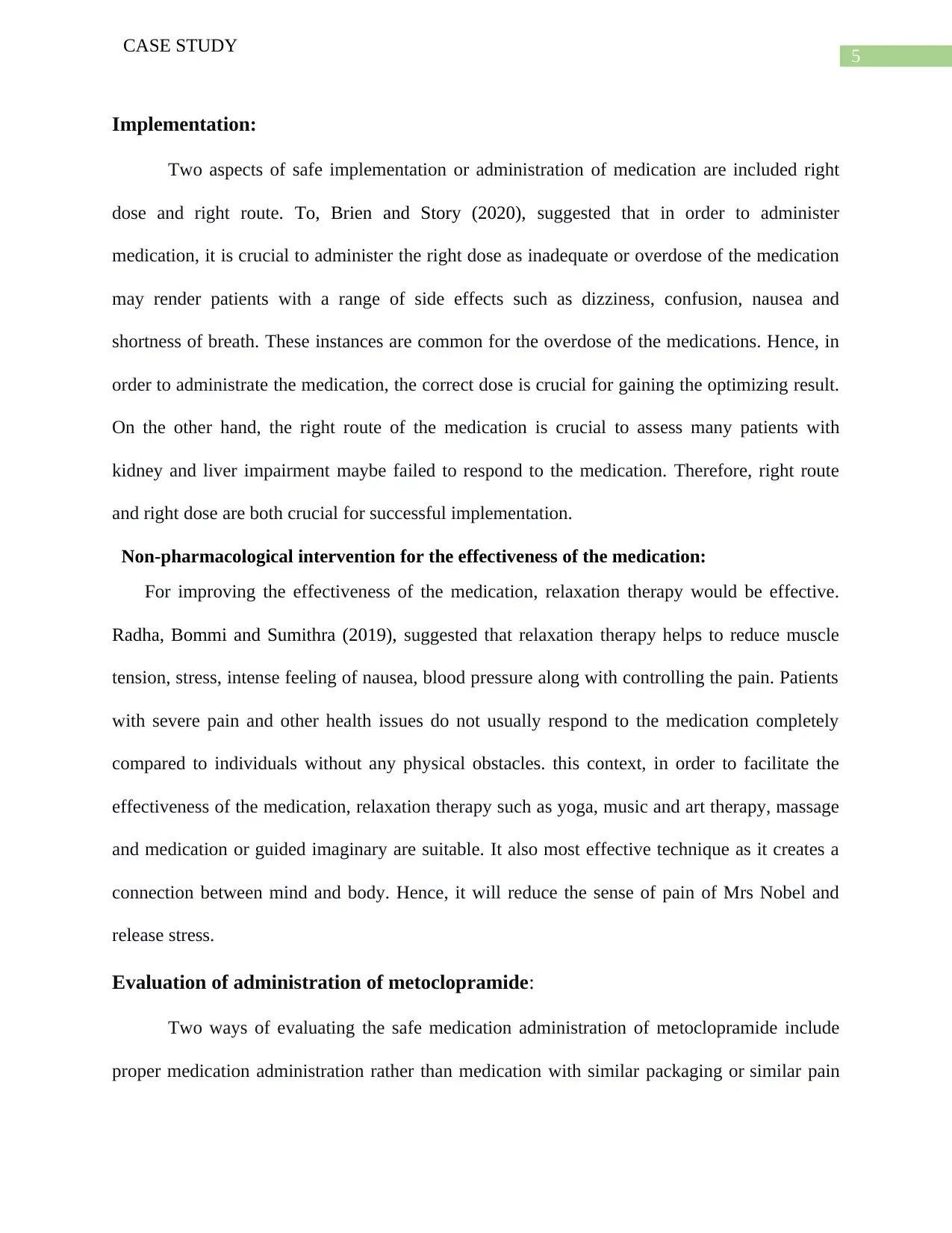
5
CASE STUDY
Implementation:
Two aspects of safe implementation or administration of medication are included right
dose and right route. To, Brien and Story (2020), suggested that in order to administer
medication, it is crucial to administer the right dose as inadequate or overdose of the medication
may render patients with a range of side effects such as dizziness, confusion, nausea and
shortness of breath. These instances are common for the overdose of the medications. Hence, in
order to administrate the medication, the correct dose is crucial for gaining the optimizing result.
On the other hand, the right route of the medication is crucial to assess many patients with
kidney and liver impairment maybe failed to respond to the medication. Therefore, right route
and right dose are both crucial for successful implementation.
Non-pharmacological intervention for the effectiveness of the medication:
For improving the effectiveness of the medication, relaxation therapy would be effective.
Radha, Bommi and Sumithra (2019), suggested that relaxation therapy helps to reduce muscle
tension, stress, intense feeling of nausea, blood pressure along with controlling the pain. Patients
with severe pain and other health issues do not usually respond to the medication completely
compared to individuals without any physical obstacles. this context, in order to facilitate the
effectiveness of the medication, relaxation therapy such as yoga, music and art therapy, massage
and medication or guided imaginary are suitable. It also most effective technique as it creates a
connection between mind and body. Hence, it will reduce the sense of pain of Mrs Nobel and
release stress.
Evaluation of administration of metoclopramide:
Two ways of evaluating the safe medication administration of metoclopramide include
proper medication administration rather than medication with similar packaging or similar pain
CASE STUDY
Implementation:
Two aspects of safe implementation or administration of medication are included right
dose and right route. To, Brien and Story (2020), suggested that in order to administer
medication, it is crucial to administer the right dose as inadequate or overdose of the medication
may render patients with a range of side effects such as dizziness, confusion, nausea and
shortness of breath. These instances are common for the overdose of the medications. Hence, in
order to administrate the medication, the correct dose is crucial for gaining the optimizing result.
On the other hand, the right route of the medication is crucial to assess many patients with
kidney and liver impairment maybe failed to respond to the medication. Therefore, right route
and right dose are both crucial for successful implementation.
Non-pharmacological intervention for the effectiveness of the medication:
For improving the effectiveness of the medication, relaxation therapy would be effective.
Radha, Bommi and Sumithra (2019), suggested that relaxation therapy helps to reduce muscle
tension, stress, intense feeling of nausea, blood pressure along with controlling the pain. Patients
with severe pain and other health issues do not usually respond to the medication completely
compared to individuals without any physical obstacles. this context, in order to facilitate the
effectiveness of the medication, relaxation therapy such as yoga, music and art therapy, massage
and medication or guided imaginary are suitable. It also most effective technique as it creates a
connection between mind and body. Hence, it will reduce the sense of pain of Mrs Nobel and
release stress.
Evaluation of administration of metoclopramide:
Two ways of evaluating the safe medication administration of metoclopramide include
proper medication administration rather than medication with similar packaging or similar pain
⊘ This is a preview!⊘
Do you want full access?
Subscribe today to unlock all pages.

Trusted by 1+ million students worldwide
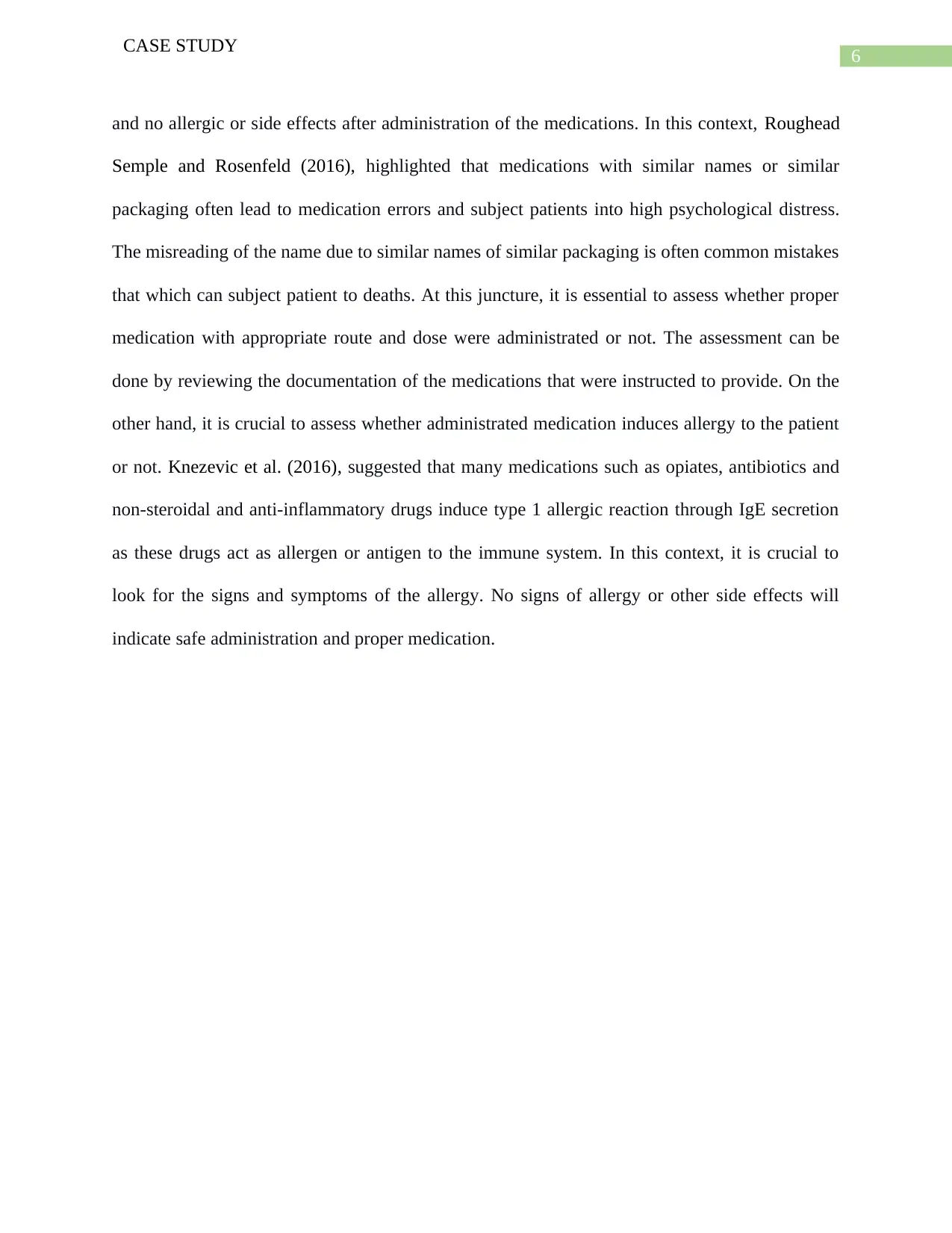
6
CASE STUDY
and no allergic or side effects after administration of the medications. In this context, Roughead
Semple and Rosenfeld (2016), highlighted that medications with similar names or similar
packaging often lead to medication errors and subject patients into high psychological distress.
The misreading of the name due to similar names of similar packaging is often common mistakes
that which can subject patient to deaths. At this juncture, it is essential to assess whether proper
medication with appropriate route and dose were administrated or not. The assessment can be
done by reviewing the documentation of the medications that were instructed to provide. On the
other hand, it is crucial to assess whether administrated medication induces allergy to the patient
or not. Knezevic et al. (2016), suggested that many medications such as opiates, antibiotics and
non-steroidal and anti-inflammatory drugs induce type 1 allergic reaction through IgE secretion
as these drugs act as allergen or antigen to the immune system. In this context, it is crucial to
look for the signs and symptoms of the allergy. No signs of allergy or other side effects will
indicate safe administration and proper medication.
CASE STUDY
and no allergic or side effects after administration of the medications. In this context, Roughead
Semple and Rosenfeld (2016), highlighted that medications with similar names or similar
packaging often lead to medication errors and subject patients into high psychological distress.
The misreading of the name due to similar names of similar packaging is often common mistakes
that which can subject patient to deaths. At this juncture, it is essential to assess whether proper
medication with appropriate route and dose were administrated or not. The assessment can be
done by reviewing the documentation of the medications that were instructed to provide. On the
other hand, it is crucial to assess whether administrated medication induces allergy to the patient
or not. Knezevic et al. (2016), suggested that many medications such as opiates, antibiotics and
non-steroidal and anti-inflammatory drugs induce type 1 allergic reaction through IgE secretion
as these drugs act as allergen or antigen to the immune system. In this context, it is crucial to
look for the signs and symptoms of the allergy. No signs of allergy or other side effects will
indicate safe administration and proper medication.
Paraphrase This Document
Need a fresh take? Get an instant paraphrase of this document with our AI Paraphraser
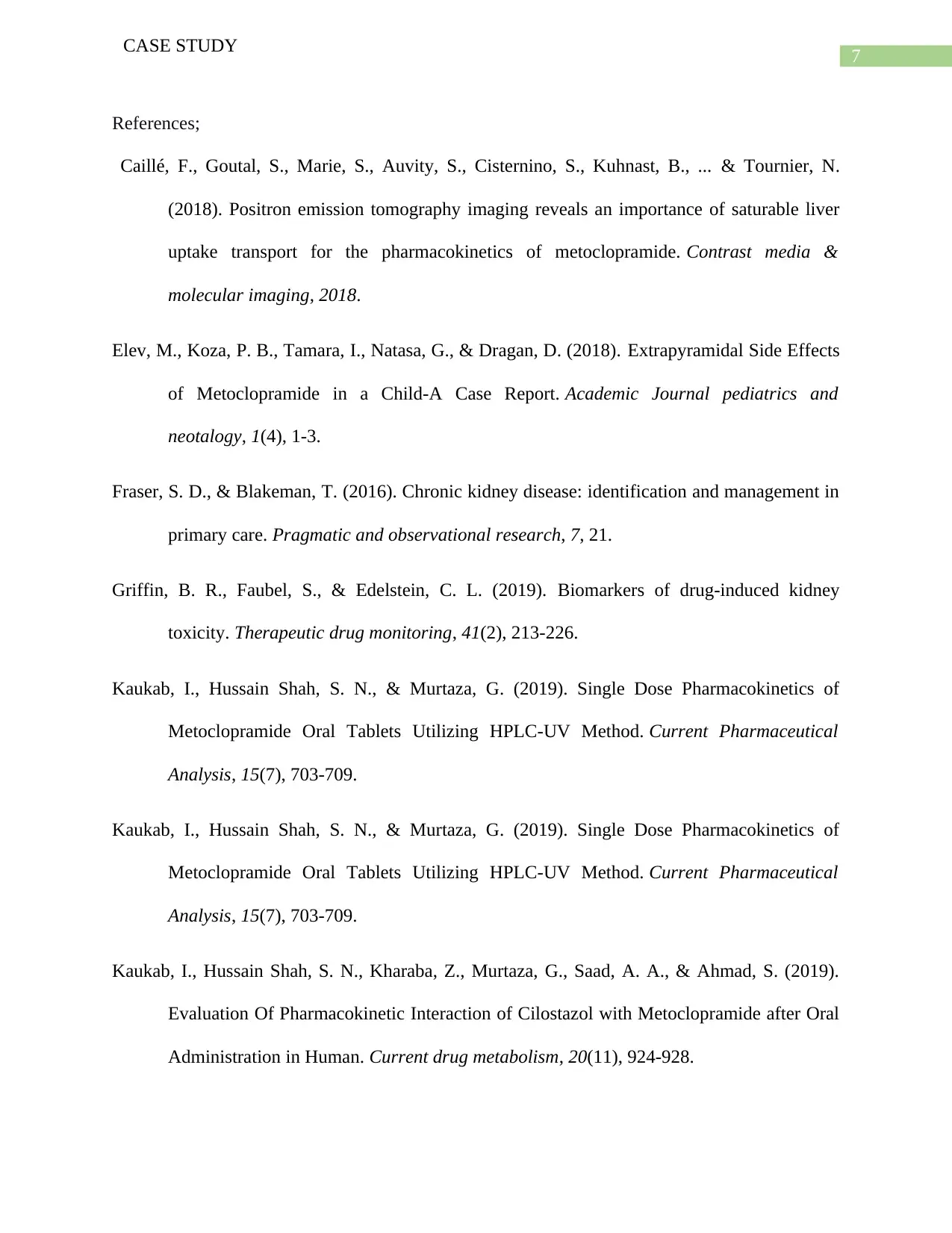
7
CASE STUDY
References;
Caillé, F., Goutal, S., Marie, S., Auvity, S., Cisternino, S., Kuhnast, B., ... & Tournier, N.
(2018). Positron emission tomography imaging reveals an importance of saturable liver
uptake transport for the pharmacokinetics of metoclopramide. Contrast media &
molecular imaging, 2018.
Elev, M., Koza, P. B., Tamara, I., Natasa, G., & Dragan, D. (2018). Extrapyramidal Side Effects
of Metoclopramide in a Child-A Case Report. Academic Journal pediatrics and
neotalogy, 1(4), 1-3.
Fraser, S. D., & Blakeman, T. (2016). Chronic kidney disease: identification and management in
primary care. Pragmatic and observational research, 7, 21.
Griffin, B. R., Faubel, S., & Edelstein, C. L. (2019). Biomarkers of drug-induced kidney
toxicity. Therapeutic drug monitoring, 41(2), 213-226.
Kaukab, I., Hussain Shah, S. N., & Murtaza, G. (2019). Single Dose Pharmacokinetics of
Metoclopramide Oral Tablets Utilizing HPLC-UV Method. Current Pharmaceutical
Analysis, 15(7), 703-709.
Kaukab, I., Hussain Shah, S. N., & Murtaza, G. (2019). Single Dose Pharmacokinetics of
Metoclopramide Oral Tablets Utilizing HPLC-UV Method. Current Pharmaceutical
Analysis, 15(7), 703-709.
Kaukab, I., Hussain Shah, S. N., Kharaba, Z., Murtaza, G., Saad, A. A., & Ahmad, S. (2019).
Evaluation Of Pharmacokinetic Interaction of Cilostazol with Metoclopramide after Oral
Administration in Human. Current drug metabolism, 20(11), 924-928.
CASE STUDY
References;
Caillé, F., Goutal, S., Marie, S., Auvity, S., Cisternino, S., Kuhnast, B., ... & Tournier, N.
(2018). Positron emission tomography imaging reveals an importance of saturable liver
uptake transport for the pharmacokinetics of metoclopramide. Contrast media &
molecular imaging, 2018.
Elev, M., Koza, P. B., Tamara, I., Natasa, G., & Dragan, D. (2018). Extrapyramidal Side Effects
of Metoclopramide in a Child-A Case Report. Academic Journal pediatrics and
neotalogy, 1(4), 1-3.
Fraser, S. D., & Blakeman, T. (2016). Chronic kidney disease: identification and management in
primary care. Pragmatic and observational research, 7, 21.
Griffin, B. R., Faubel, S., & Edelstein, C. L. (2019). Biomarkers of drug-induced kidney
toxicity. Therapeutic drug monitoring, 41(2), 213-226.
Kaukab, I., Hussain Shah, S. N., & Murtaza, G. (2019). Single Dose Pharmacokinetics of
Metoclopramide Oral Tablets Utilizing HPLC-UV Method. Current Pharmaceutical
Analysis, 15(7), 703-709.
Kaukab, I., Hussain Shah, S. N., & Murtaza, G. (2019). Single Dose Pharmacokinetics of
Metoclopramide Oral Tablets Utilizing HPLC-UV Method. Current Pharmaceutical
Analysis, 15(7), 703-709.
Kaukab, I., Hussain Shah, S. N., Kharaba, Z., Murtaza, G., Saad, A. A., & Ahmad, S. (2019).
Evaluation Of Pharmacokinetic Interaction of Cilostazol with Metoclopramide after Oral
Administration in Human. Current drug metabolism, 20(11), 924-928.

8
CASE STUDY
Kaukab, I., Hussain Shah, S. N., Kharaba, Z., Murtaza, G., Saad, A. A., & Ahmad, S. (2019).
Evaluation Of Pharmacokinetic Interaction of Cilostazol with Metoclopramide after Oral
Administration in Human. Current drug metabolism, 20(11), 924-928.
Kenward, H., Elliott, J., Lee, T., & Pelligand, L. (2017). Anti-nausea effects and
pharmacokinetics of ondansetron, maropitant and metoclopramide in a low-dose cisplatin
model of nausea and vomiting in the dog: a blinded crossover study. BMC veterinary
research, 13(1), 244.
Knezevic, B., Sprigg, D., Seet, J., Trevenen, M., Trubiano, J., Smith, W., ... & Lucas, M. (2016).
The revolving door: antibiotic allergy labelling in a tertiary care centre. Internal medicine
journal, 46(11), 1276-1283.
Le, P. P. (2019). Patient access to opioid substitution treatment pharmacy and medical service
providers in South Australia: geospatial mapping. Australian journal of primary
health, 25(2), 125-130.
Madisch, A., Vinson, B. R., Abdel-Aziz, H., Kelber, O., Nieber, K., Kraft, K., & Storr, M.
(2017). Modulation of gastrointestinal motility beyond metoclopramide and
domperidone. Wiener Medizinische Wochenschrift, 167(7-8), 160-168.
Meegada, S., Heda, R. P., Satapathy, S., & Verma, R. (2019). Metoclopramide-induced
Serotonin Syndrome. Cureus, 11(12).
Polasek, T. M., Rayner, C. R., Peck, R. W., Rowland, A., Kimko, H., & Rostami‐Hodjegan, A.
(2019). Toward dynamic prescribing information: codevelopment of companion model‐
informed precision dosing tools in drug development. Clinical pharmacology in drug
development, 8(4), 418-425.
CASE STUDY
Kaukab, I., Hussain Shah, S. N., Kharaba, Z., Murtaza, G., Saad, A. A., & Ahmad, S. (2019).
Evaluation Of Pharmacokinetic Interaction of Cilostazol with Metoclopramide after Oral
Administration in Human. Current drug metabolism, 20(11), 924-928.
Kenward, H., Elliott, J., Lee, T., & Pelligand, L. (2017). Anti-nausea effects and
pharmacokinetics of ondansetron, maropitant and metoclopramide in a low-dose cisplatin
model of nausea and vomiting in the dog: a blinded crossover study. BMC veterinary
research, 13(1), 244.
Knezevic, B., Sprigg, D., Seet, J., Trevenen, M., Trubiano, J., Smith, W., ... & Lucas, M. (2016).
The revolving door: antibiotic allergy labelling in a tertiary care centre. Internal medicine
journal, 46(11), 1276-1283.
Le, P. P. (2019). Patient access to opioid substitution treatment pharmacy and medical service
providers in South Australia: geospatial mapping. Australian journal of primary
health, 25(2), 125-130.
Madisch, A., Vinson, B. R., Abdel-Aziz, H., Kelber, O., Nieber, K., Kraft, K., & Storr, M.
(2017). Modulation of gastrointestinal motility beyond metoclopramide and
domperidone. Wiener Medizinische Wochenschrift, 167(7-8), 160-168.
Meegada, S., Heda, R. P., Satapathy, S., & Verma, R. (2019). Metoclopramide-induced
Serotonin Syndrome. Cureus, 11(12).
Polasek, T. M., Rayner, C. R., Peck, R. W., Rowland, A., Kimko, H., & Rostami‐Hodjegan, A.
(2019). Toward dynamic prescribing information: codevelopment of companion model‐
informed precision dosing tools in drug development. Clinical pharmacology in drug
development, 8(4), 418-425.
⊘ This is a preview!⊘
Do you want full access?
Subscribe today to unlock all pages.

Trusted by 1+ million students worldwide
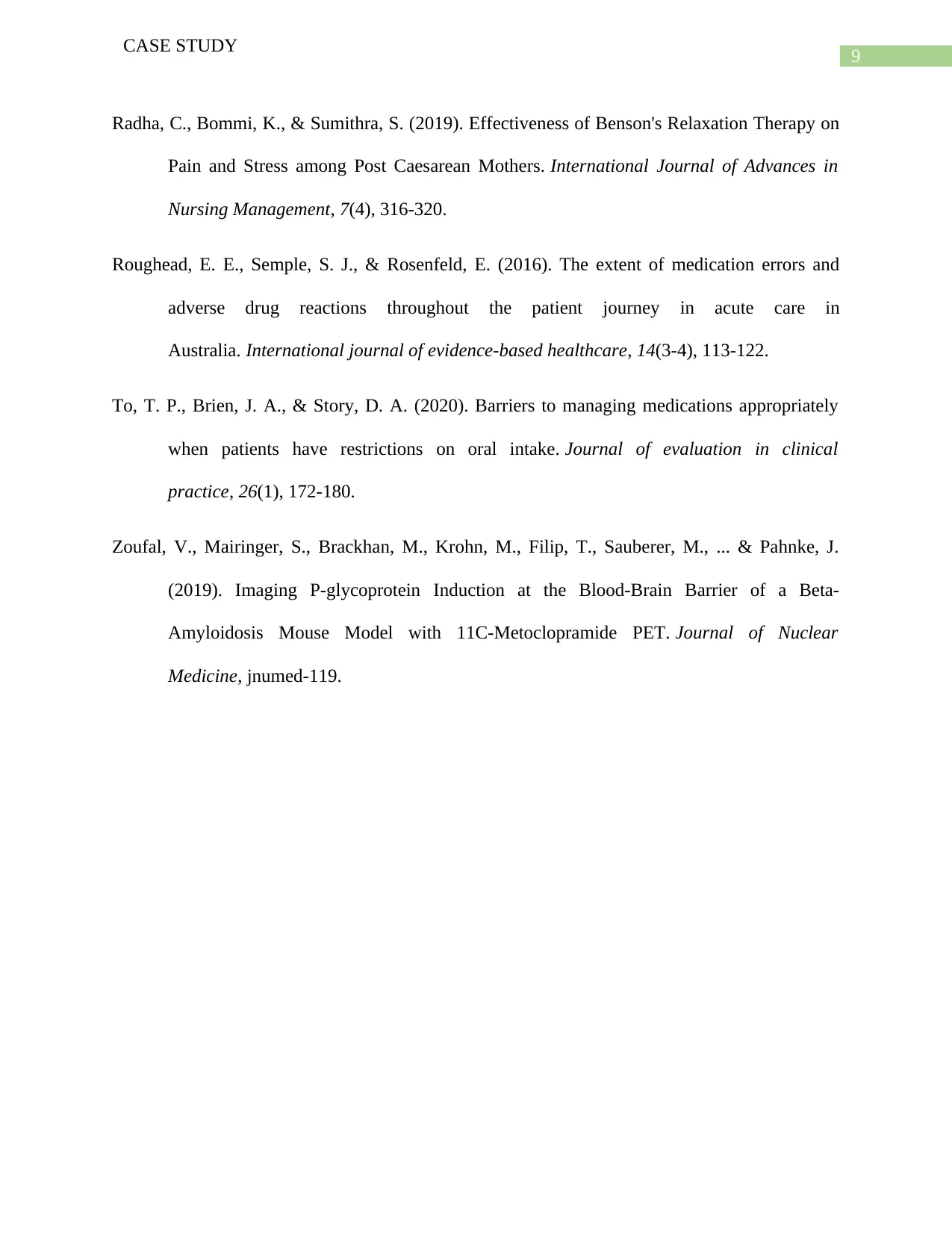
9
CASE STUDY
Radha, C., Bommi, K., & Sumithra, S. (2019). Effectiveness of Benson's Relaxation Therapy on
Pain and Stress among Post Caesarean Mothers. International Journal of Advances in
Nursing Management, 7(4), 316-320.
Roughead, E. E., Semple, S. J., & Rosenfeld, E. (2016). The extent of medication errors and
adverse drug reactions throughout the patient journey in acute care in
Australia. International journal of evidence-based healthcare, 14(3-4), 113-122.
To, T. P., Brien, J. A., & Story, D. A. (2020). Barriers to managing medications appropriately
when patients have restrictions on oral intake. Journal of evaluation in clinical
practice, 26(1), 172-180.
Zoufal, V., Mairinger, S., Brackhan, M., Krohn, M., Filip, T., Sauberer, M., ... & Pahnke, J.
(2019). Imaging P-glycoprotein Induction at the Blood-Brain Barrier of a Beta-
Amyloidosis Mouse Model with 11C-Metoclopramide PET. Journal of Nuclear
Medicine, jnumed-119.
CASE STUDY
Radha, C., Bommi, K., & Sumithra, S. (2019). Effectiveness of Benson's Relaxation Therapy on
Pain and Stress among Post Caesarean Mothers. International Journal of Advances in
Nursing Management, 7(4), 316-320.
Roughead, E. E., Semple, S. J., & Rosenfeld, E. (2016). The extent of medication errors and
adverse drug reactions throughout the patient journey in acute care in
Australia. International journal of evidence-based healthcare, 14(3-4), 113-122.
To, T. P., Brien, J. A., & Story, D. A. (2020). Barriers to managing medications appropriately
when patients have restrictions on oral intake. Journal of evaluation in clinical
practice, 26(1), 172-180.
Zoufal, V., Mairinger, S., Brackhan, M., Krohn, M., Filip, T., Sauberer, M., ... & Pahnke, J.
(2019). Imaging P-glycoprotein Induction at the Blood-Brain Barrier of a Beta-
Amyloidosis Mouse Model with 11C-Metoclopramide PET. Journal of Nuclear
Medicine, jnumed-119.
1 out of 10
Related Documents
Your All-in-One AI-Powered Toolkit for Academic Success.
+13062052269
info@desklib.com
Available 24*7 on WhatsApp / Email
![[object Object]](/_next/static/media/star-bottom.7253800d.svg)
Unlock your academic potential
Copyright © 2020–2025 A2Z Services. All Rights Reserved. Developed and managed by ZUCOL.





